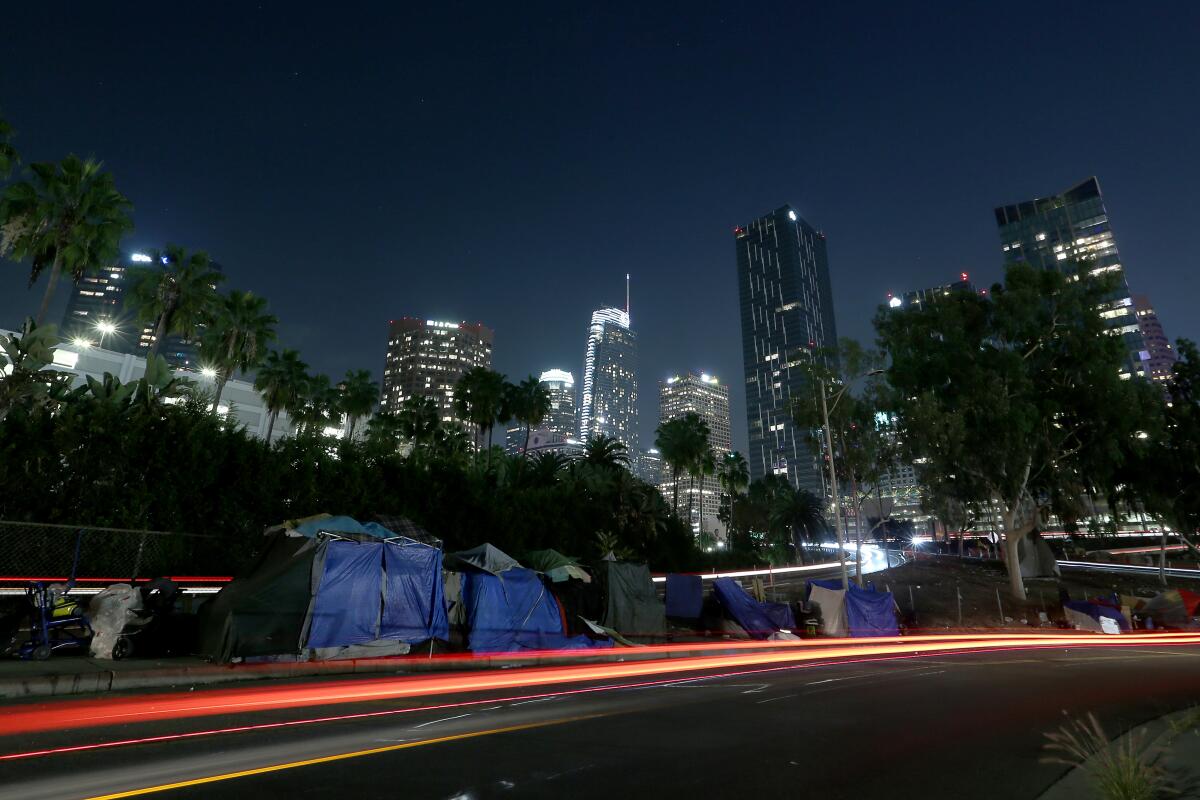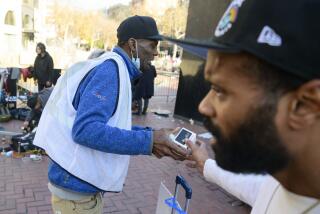The powerful synthetic opioid fentanyl is behind rising deaths in the homeless population

- Share via
A sharp rise in deaths of homeless people starting in the spring of 2020 was driven by drug overdoses involving fentanyl, a report released Thursday by the Los Angeles County Department of Public Health concluded.
Through the first seven months of 2020, 926 homeless people died in L.A. County, an increase of 26% over the same period in 2019.
For the record:
11:46 p.m. Jan. 7, 2021A previous version of this article misspelled the first name of Office of Diversion and Reentry official Shoshanna Scholar as Soshanna.
Though COVID-19 became the second-leading cause of death in the overall Los Angeles population, it remained a minor factor in homeless deaths, following heart disease, transportation-related accidents and homicide — which all lagged far behind drug overdoses.
“Despite the relatively smaller direct impact of COVID-19 … the first seven months of 2020 saw an alarming increase in overdose deaths in this population,” said the report, conducted by the county’s Center for Health Impact Evaluation. “This increase was driven largely by the more frequent involvement of fentanyl.”
“Overdose is an absolute plague in the homeless community,” Darren Willett, director of harm reduction at Homeless Healthcare Los Angeles, said in a briefing on the report, which covered both 2019 and 2020.
The increase in deaths apparently leveled off slightly later in the year. The L.A. County Department of Medical Examiner-Coroner’s preliminary estimate of 1,383 deaths of homeless people in 2020 would be a year-over-year increase of about 9%.
The county’s second annual report on homeless mortality found that drug overdoses were responsible for just under 30% of homeless deaths in 2020, by far the leading cause.
Methamphetamine, determined to be involved in nearly two-thirds of those deaths, remained the dominant contributor. But the presence of the powerful synthetic opioid fentanyl in the mix of drugs generally found in a person’s system more than doubled to 41%.
The report listed recommendations to reduce fatalities, including enhanced street outreach, more interim housing, chronic disease management, increased distribution of the antidote naloxone, a dramatic increase in residential beds for treating substance use disorder and increasing opportunities for diversion from jail to substance abuse treatment.
During the briefing, service providers stressed “harm reduction”— the use of naloxone, syringe exchange programs and sanctioned drug-use locations — as the most effective responses.
“One of the primary reasons why people are dying from overdoses is that they’re using alone,” Willett said. “They don’t have people to call for help, to reverse the overdose.”
According to Willett, of the homeless skid row residents responding to a community needs assessment who said they inject drugs, 92% have used alone in the last year, and 60% of those said they use alone daily.
“This hiding in the shadows, hiding in the tents, hiding in the alleyways is undoubtedly the result of the criminality and the social disenfranchisement by the war on drugs,” he said.
Of those surveyed, only 30% said they had ever gone to a shelter. That percentage would probably increase if shelters allowed drug use, the survey found.
“Change one factor — if you could use drugs, would you access them? — 80% said they would,” Willett said.
Willett said he did not favor allowing drug use across the board in shelters but advocated having some shelters specifically for drug users.
Shoshanna Scholar of the county Office of Diversion and Reentry said that since January, the agency has provided 50,000 doses of naloxone to inmates leaving the jails to address mortality rates up to 136% higher than the general population among those with justice system involvement.
She credited the program with 3,000 overdose reversals.
The report did not attempt to calculate a mortality rate for last year because of the lack of current information on the number of homeless people.
Its authors said that they would explore the possibility that COVID-19 had an indirect effect on the rise in homeless deaths but that they did not have enough information to draw conclusions.
The annual count, conducted last January, showed an increase of 13% in people living on the streets or in shelters in 2019. Dramatic job losses resulting from the COVID-19 pandemic are likely to have rendered more people homeless, but there is no way to quantify that.
Last year’s increase in the number of homeless people had a counterintuitive effect of slowing a multiyear rise in the homeless mortality rate, despite the number of homeless deaths increasing markedly.
The overall mortality rate — that is, the number of people dying out of each 100,000 — rose only slightly in 2019, after steeper increases in previous years, the report said.
Overall, homeless people were three times more likely to die of any cause than the whole population. Their likelihood of dying was 36 times higher from a drug or alcohol overdose, four times higher from heart disease, 17 times higher from transportation-related injuries, 15 times higher by homicide and eight times higher by suicide.
Drug overdose was not associated with youth. The highest rates and the sharpest increase in 2019 were among those ages 55 to 61, followed by those 62 and older.
The mortality rate from drug overdose was highest for white people but remained stable in 2019, while the rates for Black people increased by 45% and for Latinos by 17%.
“It appears that the continued increase in overdose mortality rates in 2019, especially among Black and Latinx [people experiencing homelessness], was largely driven by the increased involvement of fentanyl in overdose deaths in these racial/ethnic groups,” the report said.
The overdose rate among homeless women was only slightly less than for men, a notable difference from the overall population in which men are more than twice as likely as women to fatally overdose.
More to Read
Sign up for Essential California
The most important California stories and recommendations in your inbox every morning.
You may occasionally receive promotional content from the Los Angeles Times.











